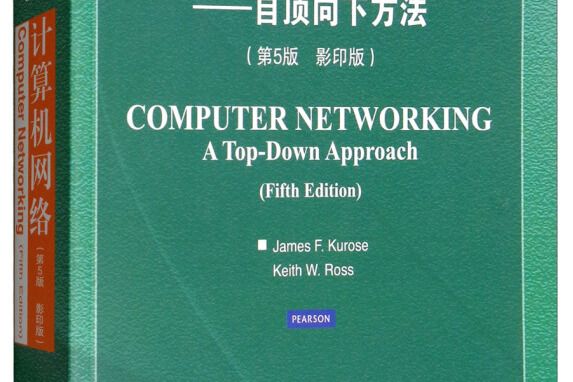內容簡介
《計算機網路:自頂向下方法(第5版 影印版)》保留了原先版本的重要特點:其自頂向下方法;對網際網路進行重點講解;對原理和實踐並重;對於學習計算機網路的親和風格和方法。主要變化在於:增加了新的一章“無線與行動網路”,包括對802.11的深入探討、蜂窩式網際網路接入概述以及對網際網路和蜂窩網移動性的全面介紹。
《計算機網路:自頂向下方法(第5版 影印版)》介紹計算機網路基礎知識,並涵蓋了“無線與行動網路”、“多媒體網路”、“網路安全”、“網路管理”四個高級專題。另外,還增加了易於操作的乙太網實驗,包括直觀用戶界面、分析近400個協定的功能,並增加兩個新的Socket程式設計作業。
《計算機網路:自頂向下方法(第5版 影印版)》內容經新、擴充後,反映了近年計算機網路領域的快速變化:P2P網路,BGP,MPLS,網路安全,廣播路由,網際網路定址與轉發。
《計算機網路:自頂向下方法(第5版 影印版)》是在第1版的基礎上修訂而成的。修訂後的《計算機網路:自頂向下方法(第5版)(影印版)》共分9章,主要內容包括:計算機網路和網際網路,套用層,運輸層,網路層,鏈路層和區域網路,無線網路和行動網路,多媒體網路,計算機網路中的安全,網路管理。可供各大專院校作為教材使用,也可供從事相關工作的人員作為參考用書使用。
圖書目錄
Chapter 1 Computer Networks andthe Internet
1.1 What Is the Internet?
1.1.1 A Nuts—and—Bolts Description
1.1.2 A Services Description
1.1.3 What Is a Protocol?
1.2 The Network Edge
1.2.1 Client and Server Programs
1.2.2 Access Networks
1.2.3 Physical Media
1.3 The Network Core
1.3.1 Circuit Switching and Packet Switching
1.3.2 How Do Packets Make Their Way Through Packet—Switched Networks?
1.3.3 ISPs and Internet Backbones
1.4 Delay, Loss, and Throughput in Packet—Switched Networks
1.4.1 Overview of Delay in Packet—Switched Networks
1.4.2 Queuing Delay and Packet Loss
1.4.3 End—to—End Delay
1.4.4 Throughput in Computer Networks
1.5 Protocol Layers and Their Service Models
1.5.1 Layered Architecture
1.5.2 Messages, Segments, Datagrams, and Frames
1.6 Networks Under Attack
1.7 History of Computer Networking and the Internet
1.7.1 The Development of Packet Switching:1961—1972
1.7.2 Proprietary Networks and Internetworking:1972—1980
1.7.3 A Proliferation of Networks:1980—1990
1.7.4 The Internet Explosion:The 1990s
1.7.5 Recent Developments
1.8 Summary
Road—Mapping This Book
Homework Problems and Questions
Problems
Discussion Questions
Ethereal Lab
Interview:Leonard Kleinrock
Chapter 2 Application Layer
2.1 Principles of Network Applications
2.1.1 Network Application Architectures
2.1.2 Processes Communicating
2.1.3 Transport Services Available to Applications
2.1.4 Transport Services Provided by the Internet
2.1.5 Application—Layer Protocols
2.1.6 Network Applications Covered in This Book
2.2 The Web and HTTP
2.2.1 Overview of HTTP
2.2.2 Non—persistent and Persistent Connections
2.2.3 HTTP Message Format
2.2.4 User—Server Interaction:Cookies
2.2.5 Web Caching
2.2.6 The Conditional GET
2.3 File Transfer:FTP
2.3.1 FTP Commands and Replies
2.4 Electronic Mail in the Interact
2.4.1 SMTP
2.4.2 Comparison with HTTP
2.4.3 Mail Message Formats and MIME
2.4.4 Mail Access Protocols
2.5 DNS—The Internet's Directory Service
2.5.1 Services Provided by DNS
2.5.2 Overview of How DNS Works
2.5.3 DNS Records and Messages
2.6 Peer—to—Peer Applications
2.6.1 P2P File Distribution
2.6.2 Searching for Information in a P2P Community
2.6.3 Case Study:P2P Internet Telephony with Skype
2.7 Socket Programming with TCP
2.7.1 Socket Programming with TCP
2.7.2 An Example Client—Server Application in Java
2.8 Socket Programming with UDP
2.9 Summary
Homework Problems and Questions
Problems
Discussion Questions
Socket Programming Assignments
Wireshark Labs
Interview: Bram Cohen
Chapter 3 Transport Layer
3.1 Introduction and Transport—Layer Services
3.1.1 Relationship Between Transport and Network Layers
3.1.2 Overview of the Transport Layer in the Internet
3.2 Multiplexing and Demultiplexing
3.3 Connectionless Transport: UDP
3.3.1 UDP Segment Structure
3.3.2 UDP Checksum
3.4 Principles of Reliable Data Transfer
3.4.1 Building a Reliable Data Transfer Protocol
3.4.2 Pipelined Reliable Data Transfer Protocols
3.4.3 Go—Back—N (GBN)
3.4.4 Selective Repeat (SR)
3.5 Connection—Oriented Transport: TCP
3.5.1 The TCP Connection
3.5.2 TCP Segment Structure.
3.5.3 Round—Trip Time Estimation and Timeout
3.5.4 Reliable Data Transfer
3.5.5 Flow Control
3.5.6 TCP Connection Management
3.6 Principles of Congestion Control
3.6.1 The Causes and the Costs of Congestion
3.6.2 Approaches to Congestion Control
3.6.3 Network—Assisted Congestion—Control Example:ATM ABR Congestion Control
3.7 TCP Congestion Control
3.7.1 Fairness
3.8 Summary
Homework Problems and Questions
Problems
Discussion Questions
Programming Assignments
Wireshark Lab: Exploring TCP
Interview: Sally Floyd
Chapter 4 The Network Layer
4.1 Introduction
4.1.1 Forwarding and Routing
4.1.2 Network Service Models
4.2 Virtual Circuit and Datagram Networks
4.2.1 Virtual—Circuit Networks
4.2.2 DatagramNetworks
4.2.3 Origins ofVC and Datagram Networks
4.3 What's Inside a Router?
4.3.1 Input Ports
4.3.2 Switching Fabric
4.3.3 Output Ports
4.3.4 Where Does Queuing Occur?
4.4 The Internet Protocol (IP): Forwarding and Addressing in the Internet
4.4.1 Datagram Format
4.4.2 IPv4 Addressing
4.4.3 Internet Control Message Protocol (ICMP)
4.4.4 IPv6
4.4.5 A Brief Foray into lP Security
4.5 Routing Algorithms
4.5.1 The Link—State (LS) Routing Algorithm
4.5.2 The Distance—Vector (DV) Routing Algorithm
4.5.3 Hierarchical Routing
4.6 Routing in the Internet
4.6.1 Intra—AS Routing in the Internet: RIP
4.6.2 Intra—AS Routing in the Internet: OSPF
4.6.3 Inter—AS Routing: BGP
4.7 Broadcast and Multicast Routing
4.7.1 Broadcast Routing Algorithms
4.7.2 Multicast
4.8 Summary
Homework Problems and Questions
Problems
Discussion Questions
Programming Assignment
Wireshark Labs
Interview: Vinton G.Cerf
……
Chapter 5 The Link Layer and Local Area Networks
Chapter 6 Wireless and Mobile Networks
Chapter 7 Multimedia Networking
Chapter 8 Security in Computer Networks
Chapter 9 Network Management
References
Index

